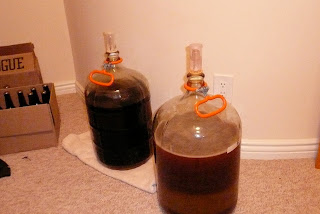It's been a while since I posted anything about my own brewing. In part because I've been busy, but also because I've been working on two beers that ended up taking quite a bit of time, and alas, my setup is only two carboys and one bucket deep, so I can only do so much at a time.
However, I'm very happy to announce that I now have two beers finished and ready to drink, with one beer freshly bottled and ready within the few weeks and a double IPA busily churning away in the closet. I'll talk about Cossack's Wisecrack, my Russian Imperial Stout, in this post, and I'll do separate posts about my ginger saison and blood orange hefeweizen.
The Cossack started out all the way back in December when I – heavily bearded at the time – was taken by the desire to make a heavy and powerful Russian Imperial Stout. I had recently drank Avery's The Czar on tap, which is a truly incredible beer, and I wanted to see if I could make something in that vein.
The Recipe:
Grain Bill:
6 oz Carahell
5 oz Carafa III
5 oz British Chocolate
5 oz Weyerman Dehusked Carafa III
12 oz Cara Munich
12 lbs dry dark malt extract
3/4 lbs brown sugar
Hopping Schedule:
60 min - 1.5 oz Chinook
45 min - .7 oz Chinook
15 min - 1.5 oz Northern
0 min - 1 oz Willamette
SG: 1.104
Lastly, I used 2 packets of dry yeast for this since I wanted an aggressive ferment.
I was hoping to simplify my boil by using a propane tank and burner from a turkey fryer. I figured this would help me get my heat up a lot faster, which I've noticed takes quite a bit of time with 4 gallons of liquid on a stovetop. Unfortunately, I didn't get any pictures of this, but the process was unsuccessful. I was able to get the heat up substantially quicker, but didn't expect the massive boil over that resulted. The cooling time on my brew pot was also substantially longer, so in the end I think I spent the same amount of time boiling my wort as I would have on a stovetop. On top of all that, you spend most of the time eyeing the device precariously, as it wouldn't take much for a strong gust of wind or knocked over burner to turn that propane tank into a massive bomb.
After a decent ferment, I decided to let this sit in the secondary for an extended period of time. The alcohol content was getting up there, but I wanted to allow the flavors to work themselves through all that heavy body. After a few tasty beers that hadn't backed themselves up in alcohol worthiness, I was committed making a beer that was high gravity. In order to ensure this I added maple syrup to the end of the primary and beginning of the secondary to give the yeast a little more to chow down on.
After tasting this in the secondary about 2 months in, I had a real nice stout going, good burned grain flavor with some roasted tones. However, I wanted to ensure this beer's place as a clearly defined Russian Imperial, not just a good stout, and that meant only one thing: bourbon barrels.
So I decided to try my first oak aging. Unable to procure an actual used oak barrel, I settled on using oak chips. I soaked new oak chips in around 3 cups of wild turkey 101 for around two weeks. Afterwards, I added it all directly to the secondary for one week and then bottled.
I had read that new oak chips, which I used can quickly overwhelm a beer which is why I only left them in for one week. But even after just that minimal amount of time, the beer was far too saturated with bourbon.
On the plus side, as you can see the body was heavy, thick, and rich, exactly how you want a Russian Imperial to be. I gave the bottles an extra month to work out some of the bourbon flavor (they are currently on a month and a half), which seems to have helped a little. The flavor is a heavy mix of bourbon with hints of oak and roasted grains. I've now conceded that I'll never get completely back to that nice roasted barley flavor I found when I tried it from the secondary, but all in all it's a beer I'm pretty proud of for its stellar body and high alcohol content at 10.5%.
The major obstacle I've faced, however, is that about half the batch didn't get sealed properly for carbonation, so drinking these has been a little like drinking cold, heavy stout syrup. The flavors still remain though. I'm particularly proud of the labels on this one, which I've included so that you all can read.
And that's the story of the Cossack's Wisecrack. Next time, get ready for... Enter the Tiger













































